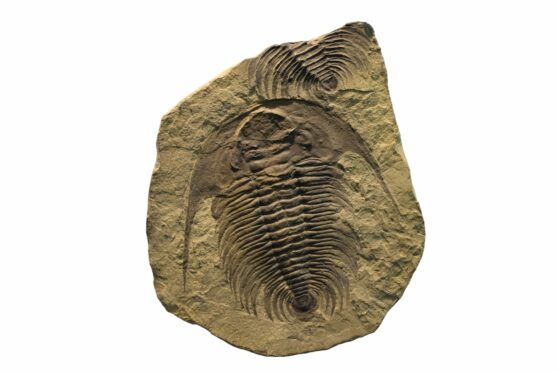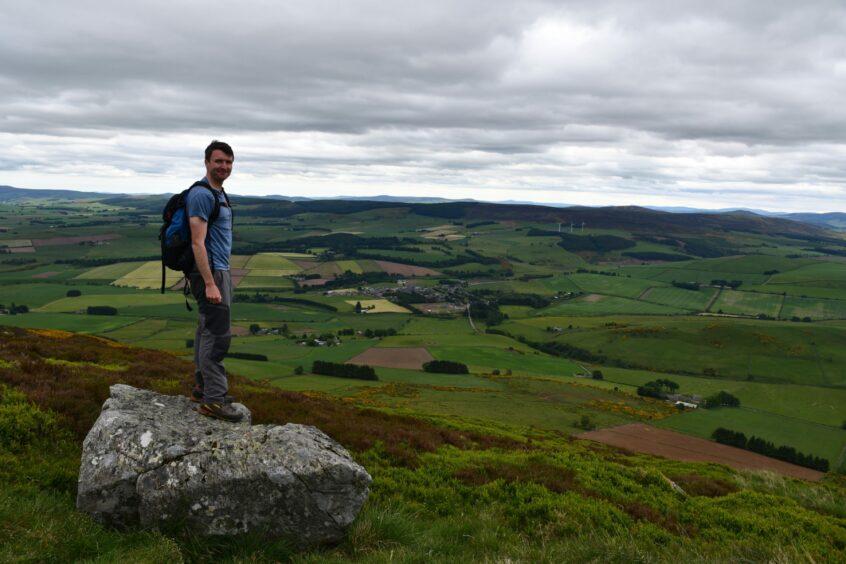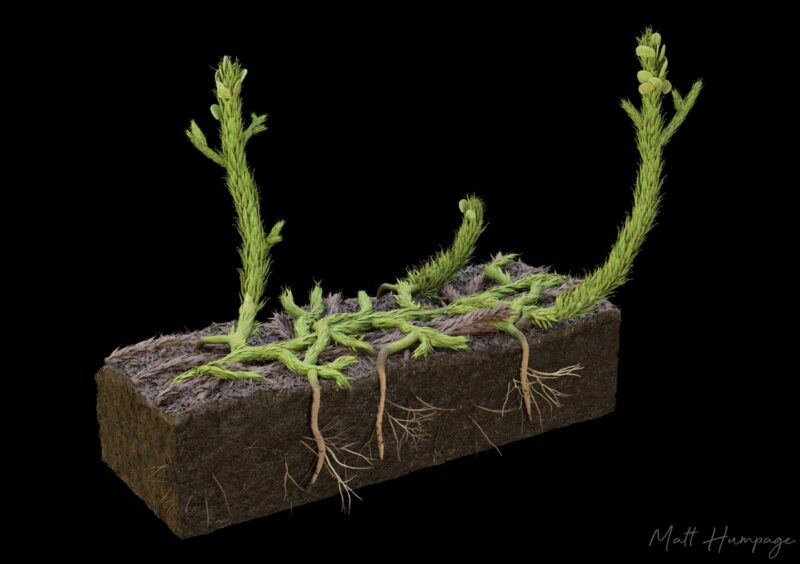
There may be castles and battlefields, monuments and museums but 37 miles west of Aberdeen, the most historically important part of Scotland lies six feet or so beneath the grass.
It is here that scientists discovered and have been studying the 407-million-year-old plant fossils that might hold the secret to life on earth.
Known as the Rhynie chert, the rock’s fossils are evidence of the earliest known ecosystem of terrestrial life and wherever the plants grew on land, animals followed.
Scientists investigating how prehistoric lobe fish developed lungs and limbs to become tetrapods – the ancestors of humans – believe it created a habitat, and potentially a food source, that may have lured the creatures from rivers and deltas on to land, paving the way for humanity itself.
Yet despite its global importance in the understanding of the evolution of terrestrial life on earth, the site on the doorstep of Europe’s bustling and cosmopolitan energy capital, Aberdeen, remains one of Scotland’s best-kept secrets.
Dr Sandy Hetherington, a palaeobiologist in the Institute of Molecular Plant Sciences at Edinburgh University, has, for six years, been studying fossils from the Rhynie chert, whose rock is made from silica (the same material as glass), and formed from hot volcanic springs. It contains plants with beautifully preserved cells, primitive spiders and the oldest known fossil insects.
He said: “The Rhynie chert is in a field grazed by sheep. It is designated as a site of special scientific interest (SSI) but there are no signs and if you walked past, you wouldn’t see it. What that actually shows us is what a terrestrial ecosystem at that time looked like.
“This is the earliest time we have early plants and animals on land in a complex ecosystem anywhere in the world.
“What is particularly interesting about this site is many of the plants are very small, so if we are thinking about that tetrapod transition, one of the reasons that this didn’t happen earlier is that there might not have been a terrestrial ecosystem and flora and fauna that could actually have sustained a large fish at that stage.
“The increase in complexity of plant life on land must have been key,” he added.
“I do think that without early terrestrial ecosystems there would not be tetrapod diversification. It doesn’t mean to say they would eat plants, but they would potentially be eating other organisms that are surviving on the plants, like arthropods.
“Scotland is key when you are talking about humankind being here as a result of the tetrapod transition. Scottish fossils are key to the evidence that we have with the early plants establishing a terrestrial surface where the animals can survive. And sites like the Rhynie chert are giving us remarkable insights that we are not getting anywhere else in the world.”
The university’s professor Steve Brusatte, a vertebrate palaeontologist and evolutionary biologist who specialises in the anatomy, genealogy, and evolution of dinosaurs and other fossil organisms, said: “It’s remarkable to think that for the first four billion years or so of Earth history, the land was barren. No grass, no trees, no plants of any kind, and no animals either, a ghostly world.
“The first colonisers of the land were plants, and they built the ecosystems that then attracted animals that came out of the water, and from there developed the hugely diverse jungles and rainforests and plains and tundras and other land ecosystems of today. None of this would have happened without those pioneering plants. There’s a line in one of my favourite movies, Field Of Dreams, about a guy who built a baseball stadium back in the Midwestern US where I grew up: ‘Build it and they will come.’ Kevin Costner was talking about his baseball field, but you could say the same about the plants.
“They built it, and the animals came.”
The Rhynie chert was discovered in 1912 by Elgin medical practitioner Dr William Mackie. He had been geologically mapping the area around Rhynie when he found some unusual siliceous rocks incorporated into a dry-stone wall field boundary. While making thin sections of the rock, he observed perfectly preserved plant axes (stems) showing detail of individual cellular structure. Luckily, he realised the profound significance of this deposit and made his find known to specialist workers in palaeontology.
Scientists from the National Museum of Scotland – which also holds samples from the chert – are part of an international and multi-disciplinary consortium researching exactly how prehistoric lobe fish over millions of years developed limbs, lungs, digits, necks and hips as well as a specially adapted circulatory system and senses that made possible their move to land.
They are also probing the reasons behind the leap and point to a number of theories including climate and environment. But they agree the emergence of an ecosystem that could provide a food source might also be key.
The museum’s Department of Natural Sciences head, Dr Nick Fraser, who specialises in vertebrate palaeontology, said: “Was it because there was a food source on land that attracted them? What was pulling animals, which were adapted to living in water, to this harsh environment on land? We know there has to have been a rich food source on the land because we have the Rhynie chert.”
And while scientists don’t have a definitive answer, he says, they are certain “the rich geology of Scotland gives it a central role in the understanding of the evolution of terrestrial life on earth.”
“The clues to the tetrapod transition could well be in Scotland,” he said, explaining that eminent scientists in the field are “drawn” here because of the country’s “incredible collection of fossils from this key time period”.
He said Scotland is a “unique place,” and would always be one of the “hubs of our understanding of the origin of vertebrate life moving on to land.”
But the Scotland of 407 million years ago – when the Rhynie chert was formed – was very different to the Scotland we know today.
Brusatte, who with other scientists shared his knowledge of the fish to tetrapod transition in the BBC Radio 4 show In Our Time, said: “Our distant ancestor was a fish that sprouted limbs, fingers and toes and moved on to the land and in doing so found new ways to breathe air and to move on dry ground.
“If this primeval fish didn’t make that leap we simply wouldn’t be here today. This leap from water to land is one of the most profound evolutionary transitions in earth’s history. It set life on a radically new course and ultimately paved the way for us. But what was the world like when this transition was happening back in the Devonian time of earth history about 400 million years ago? Unlike the map today, when most land is in the northern hemisphere, back then most land was in the south, and much of what is in the north today, what is now Asia, North America and Europe, those land masses were closer to the equator, including Scotland. Imagine a tropical Scotland, as rainy as it is today but warm rain, and humid.
“That world was becoming settled, and it was the first plants that moved on to land and we see those at Rhynie. They are not like anything we know today. They are whispy, haunting, almost alien-like things. Skinny little twigs almost a metre or so tall, but they were the precursors of forests. And living among them were arthropods or the ancestors of today’s spiders and insects. The land was now primed, there was some food on land and some shelter on land and these new ecosystems were waiting to be explored.”
And it is important, he said, to look at what the environment and what broader world was like way back then. “In this Devonian time (419.2 million years ago to 358.9 million years ago) you have glaciers developing around the poles, and you have a mass extinction later in the Devonian,” he said.
“This was probably because climates were changing dramatically with all of these new forests on land sucking carbon dioxide out of the atmosphere and the reverse greenhouse effect was happening. The world was getting colder.
“These fishes were living closer to land in shallower waters, streams, estuaries and in the tidal flat zones. So the limbs and the digits and the lungs and the necks were helping those fishes adapt to that particular world. And it just so happened that those different features that evolved for a variety of reasons, came together almost like a Lego set being assembled accidentally, and allowed some of these fishes to make the first tentative forays on to the land.
“Why they did that, who knows? Maybe they were chasing a tasty bug, or trying to escape predators, or to breathe more air. But at that point, an evolutionary threshold was crossed and then natural selection could fine-tune these fishes even more to living on that new land environment. But we can be confident that there needed to be ecosystems on land already in order for these tetrapods to have a habitable home there.”
Don’t mind the Gap: Scots’ research fills in missing links
Since the 1950s, scientists trying to find out how tetrapods made the leap from water to land found the task all the harder because of an apparent 15-million-year “gap” in the fossil record. It was known as “Romer’s Gap” after US professor Alfred Sherwood Romer, and spanned from about 360 to 345 million years ago, corresponding to the first 15 million years of the Carboniferous Period.
Fast forward past the gap and there is plenty of evidence of tetrapods on land with some of the best-preserved fossils found in Scotland, particularly at the East Kirkton Quarry in West Lothian. But how had the pre-gap water-dwellers evolved into these almost reptile-like landlubbers?
Some researchers believed that oxygen levels were too low for tetrapods to survive on land, so they simply hadn’t existed. But Edinburgh-born Stan Wood, a self-taught field palaeontologist, did not agree. With Cambridge University’s Dr Tim Smithson he went on to discover fossils in the Borders region that paved the way for the TW:eed project: Evolution’s Missing Chapter. A four-year research project funded by the Natural Environment Research Council (NERC), it started in 2012, just before Wood’s death, and was led by the late professor Jenny Clack of Cambridge University.
Studying fossils and environments from the Early Carboniferous Tournaisian Stage (roughly 350 million years ago), it also involved experts from a string of British and Canadian universities, the British Geological Survey and National Museums of Scotland (NMS). It resulted in some spectacular new finds, fossils which, according to NMS’s Dr Nick Fraser “bridged” Romer’s Gap and helped scientists in their understanding of how tetrapods moved from water on to land, the other animals and plants that existed at that time, and the environment in which these changes took place.
Dr Fraser told The Sunday Post: “We have answered a bunch of questions with our TW:eed project but have opened up a whole spate of others that we can’t yet answer. The answers may well lie in Scotland. We are getting clues from the TW:eed project as to where we focus our attention, but that doesn’t mean we stop focussing on what we have found already, because that is just the tip of the iceberg.”

Enjoy the convenience of having The Sunday Post delivered as a digital ePaper straight to your smartphone, tablet or computer.
Subscribe for only £5.49 a month and enjoy all the benefits of the printed paper as a digital replica.
Subscribe
 © Matt Humpage
© Matt Humpage